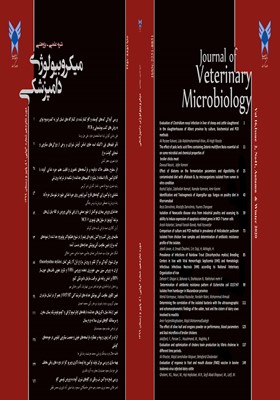بررسی و بهینه سازی میزان تولید توکسین وبا توسط باکتری ویبریو کلرا در دوره های زمانی مختلف
محورهای موضوعی : باکتری شناسی
علی خواستار
1
,
مجید جمشیدیان مجاور
2
*
![]() ,
به آفرید قلندری
3
,
به آفرید قلندری
3
1 - دانشجوی کارشناسی ارشد بیوتکنولوژی میکروبی، دانشگاه آزاد اسلامی، واحد علوم و تحقیقات، گروه زیست شناسی تهران، ایران
2 - موسسه تحقیقات واکسن و سرمسازی رازی، سازمان تحقیقات، آموزش و ترویج کشاورزی، شعبه مشهد، ایران.
3 - گروه نانوتکنولوژی پزشکی، واحد علوم و تحقیقات، دانشگاه آزاد اسلامی، تهران، ایران
کلید واژه: ویبریو کلرا, الایزا GM1, توکسین,
چکیده مقاله :
سم باکتری ویبریو کلرا یکی از مورد مطالعه ترین سموم باکتریایی خانواده AB5 است که به دلیل توانایی آن در افزایش پاسخ ایمنی نسبت به انتی ژن تزریق شده با آن به طور گسترده به عنوان یک ادجوانت موکوزال قوی مورد استفاده قرار می گیرد. این توکسین از دو زیر واحد، یک زیرواحد پنتامریک به نام زیر واحد B و یک زیرواحد A تشکیل شده است. این توکسین از طریق اتصال به گیرنده گانگلوزیدی GM1 به سلول هدف وارد می گردد. در این پژوهش باکتری ویبریو کلرا درون 100 سی سی محیط AKI و Craig’s به صورت دو گروه دوتایی کشت داده شد. سپس یک گروه درون انکوباتور 37 درجه سانتی گراد و گروه دیگر درون انکوباتور 30 درجه سانتی گراد و به مدت 72 ساعت قرار داده شد. از تمامی محیط به صورت منظم از لحظه آغاز دوره انکوباسیون به منظور بررسی میزان تولید توکسین نمونه برداری شد. در نهایت میزان تولید توکسین به وسیله آزمون الایزا GM1 مورد بررسی قرار گرفت. نتایج نشان داد که باکتری در هر دو محیط توانایی تولید توکسین به میزان نسبتا بالا را دارد. بیشترین میزان تولید توکسین در محیط کشت Craig’s در دمای 30 درجه سانتی گراد بعد از 50 ساعت مشاهده شد. همچنین نتایج حاصل از تست الایزا GM1 نشان داد که باکتری پس از 50 ساعت بیشترین تولید را در محیط Craig’s و در دمای 30 درجه سانتی گراد دارد این در حالی است که بیشترین میزان تولید توکسین در محیط AKI پس از 24 ساعت و در دما 37 درجه سانتی گراد بدست می آید.

